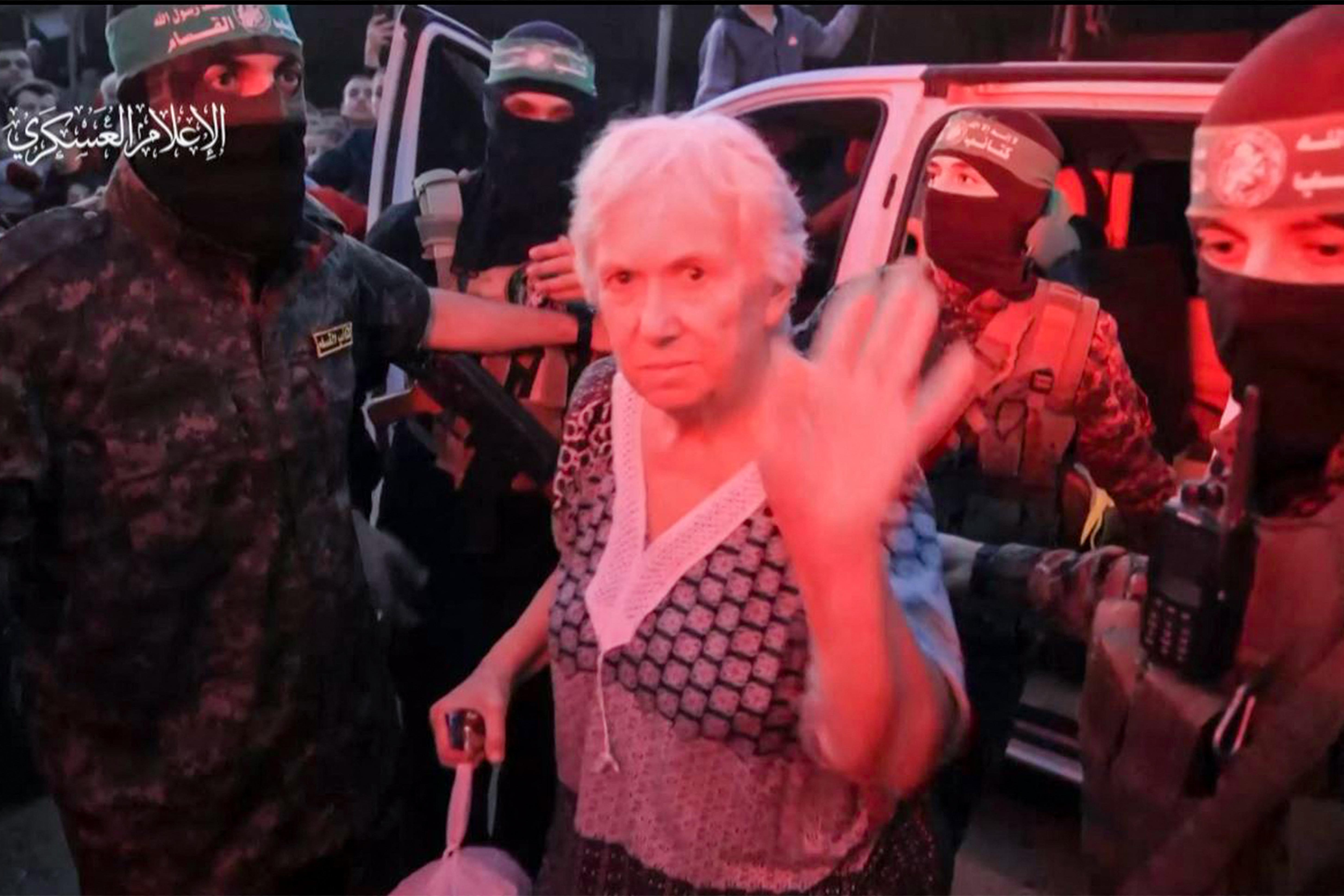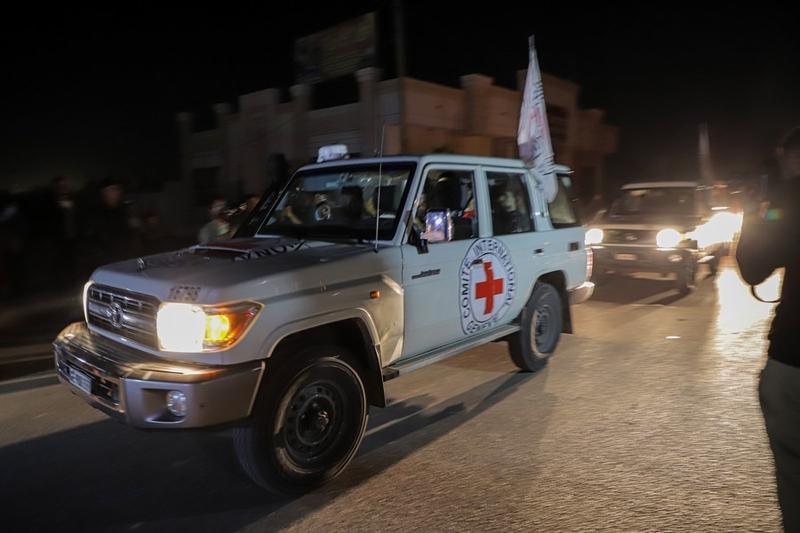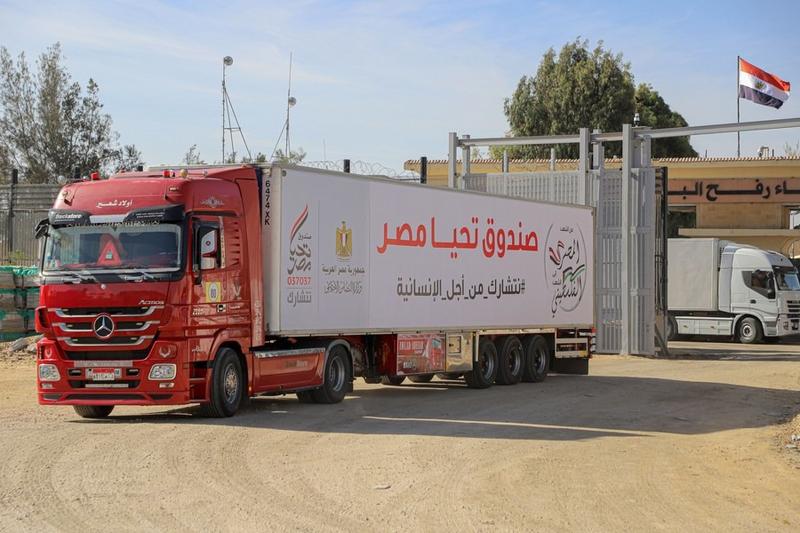 An image grab from a handout video released by the Hamas Media Office shows a hostage waving next to members of its Al-Qassam Brigades before being handed over to officials from the International Committee of the Red Cross in Gaza on Nov 24, 2023, ahead of her transfer to Israel. (HAMAS MEDIA OFFICE VIA AFP)
An image grab from a handout video released by the Hamas Media Office shows a hostage waving next to members of its Al-Qassam Brigades before being handed over to officials from the International Committee of the Red Cross in Gaza on Nov 24, 2023, ahead of her transfer to Israel. (HAMAS MEDIA OFFICE VIA AFP)
GAZA/CAIRO/JERUSALEM/UNITED NATIONS – As a cease-fire with Israel entered into force, Hamas on Friday released 24 hostages, including 13 Israelis, while buses carrying 39 Palestinian prisoners departed at night from Israeli Ofer prison.
The 13 Israeli hostages, all children and women, were sent to Egypt from Gaza and then headed for Israel. After initial reception procedures, including a medical assessment, the hostages were transferred to Israeli hospitals to reunite with their family members, the Israel Defense Forces (IDF) has said.
An addition of 10 Thai and one Filipino citizens have also arrived at the Rafah crossing after being released from Gaza, Egypt's Al Qahera News TV reported.
Earlier in the day, a Palestinian source told Xinhua that the release of non-Israeli nationals was not part of the truce deal, adding that they were released without any conditions.
The truce, mediated by Qatar and Egypt, took effect this morning at 7 am local time (0500 GMT). As part of the deal, Israel released 39 Palestinian prisoners on Friday night from its Ofer prison near the West Bank city of Ramallah after receiving the hostages.
READ MORE: Aid, fuel enter Gaza as truce between Hamas, Israel takes hold
The Palestinian prisoners, including 24 women and 15 children, were transferred to the West Bank and East Jerusalem by vehicles belonging to the Red Cross.
According to the cease-fire swap, Hamas will release at least 50 Israeli hostages, mainly children and women, in exchange for 150 female and teen Palestinian prisoners from Israeli prisons.
 Former Palestinian prisoners who were released by the Israeli authorities, fly Palestinian and Hamas flags while they are carried on their shoulders upon their arrival in the West Bank town of Beitunia, Nov 24, 2023. (PHOTO / AP)
Former Palestinian prisoners who were released by the Israeli authorities, fly Palestinian and Hamas flags while they are carried on their shoulders upon their arrival in the West Bank town of Beitunia, Nov 24, 2023. (PHOTO / AP)
Meanwhile, the cease-fire has enabled the delivery of more aid supplies to Gaza. According to a spokesman for the Gaza side of the Rafah crossing, 150 trucks carrying humanitarian aid had entered Gaza, including four carrying cooking gas and three carrying fuel.
In addition, Palestinian ambulances have crossed the Rafah crossing to the Egyptian side to transport the wounded and the sick for treatment abroad. Palestinians stranded in Egypt also began returning to Gaza.
On the other hand, when the cease-fire took effect early Friday, Palestinians across the Gaza Strip rushed to the streets to inspect their houses, check on their relatives, and try to recover and bury the dead.
Rescue workers and civil defense units have been deployed to retrieve the dead bodies from under the rubble of destroyed buildings.
However, even with a brief respite from the bombardment, Israeli forces on the ground fired bullets at the outskirts of the southern Gaza Strip and the main road leading to Gaza City and its north, Palestinian security sources and witnesses said.
 A helicopter carrying hostages released by Hamas lands at Schneider Children's Medical Center in Petah Tikva, Israel, Nov 24, 2023. (PHOTO / AP)
A helicopter carrying hostages released by Hamas lands at Schneider Children's Medical Center in Petah Tikva, Israel, Nov 24, 2023. (PHOTO / AP)
At least two Palestinians were killed and others wounded while trying to return to their homes, which were not allowed by the Israeli army, Palestinian medical and security sources said.
"The dead and wounded people were transferred to the al-Aqsa hospital in Deir al-Balah city," the Hamas-run Health Ministry said in a press statement.
Eyewitnesses told Xinhua that a number of displaced people from Beit Lahia, a city in northern Gaza, returned to their homes only to find them being completely destroyed.
Palestinian authorities called for the displaced to return to their homes in the northern strip, while Israel had warned that it would prohibit them from moving northward during the truce.
The Israeli forces stationed at a checkpoint separating northern and southern Gaza for weeks have placed additional cement barriers to prevent the movement of civilians from south to north in the enclave, said eyewitnesses.
Israeli forces invaded Gaza weeks ago and ordered residents of northern Gaza to move southward. The Israeli military now occupies much of the northern half of the strip and displaces some 1.7 million of 2.3 million Gazans.
 Vehicles belonging to the International Committee of the Red Cross transport released hostages toward the Rafah crossing in the southern Gaza Strip, Nov 24, 2023. (PHOTO /XINHUA)
Vehicles belonging to the International Committee of the Red Cross transport released hostages toward the Rafah crossing in the southern Gaza Strip, Nov 24, 2023. (PHOTO /XINHUA)
Israeli army withdraws from al-Shifa hospital
The Israeli army withdrew Friday from the al-Shifa Hospital in Gaza after raiding the premises for over a week, a Palestinian security source said.
The source, who requires anonymity, told Xinhua that "the Israeli forces detonated facilities within the complex before their withdrawal, including power generators, oxygen pumps, and radiology equipment.
The Israeli army announced on Friday they destroyed a route of underground "terrorist" tunnels and tunnel shafts beneath the al-Shifa hospital, which they say served as a Hamas hideout.
Approximately 250 patients and staff remained at the hospital, which is currently non-operational due to severe shortages of power, water, and medical supplies, according to a UN report on Thursday.
ALSO READ: UN chief wants return of two-state solution after Gaza crisis
The withdrawal came on the first day of the temporary humanitarian cease-fire between Hamas and Israel that is expected to last for four days.
 A truck with humanitarian aid enters the Gazan side of the Rafah crossing, Nov 24, 2023. (PHOTO / XINHUA)
A truck with humanitarian aid enters the Gazan side of the Rafah crossing, Nov 24, 2023. (PHOTO / XINHUA)
Largest aid convoy
The largest aid convoy since Oct 7 arrived in Gaza on Friday with 137 truckloads of aid and 129,000 liters of fuel, UN humanitarians said.
The UN Office for the Coordination of Humanitarian Affairs (OCHA) said that on the first day of the humanitarian pause in hostilities, the world body was able to scale up the delivery of humanitarian assistance into and across Gaza.
It said 200 trucks were dispatched to the Rafah crossing and 137 reached the UN Agency for Palestine Refugees (UNRWA), where they were offloaded, making it the biggest humanitarian convoy received since the outbreak of the Hamas-Israel war on Oct 7.
Some 129,000 liters of fuel and four trucks of gas also crossed into Gaza. Twenty-one critical patients were evacuated in a large-scale medical operation from the north of Gaza, it said.
READ MORE: UNICEF says Gaza most dangerous place in the world to be a child
Hundreds of thousands of people were assisted with food, water, medical supplies and other essential humanitarian items. Humanitarian teams from the United Nations and partners will continue to ramp up humanitarian operations to meet the needs of people throughout Gaza in the coming days, said the office, referring to the negotiated four-day humanitarian pause.
Over 1.7 million people in Gaza are estimated to be internally displaced, with about 1 million staying in at least 156 UNRWA shelters across the Gaza Strip, OCHA said. The shelters are accommodating far more people than their intended capacity, and despite being unable to accommodate new arrivals, people continue to arrive.
As of Thursday, about 200 patients and medical staff at the Indonesian hospital in Beit Lahiya in northern Gaza awaited evacuation, the humanitarians said.


